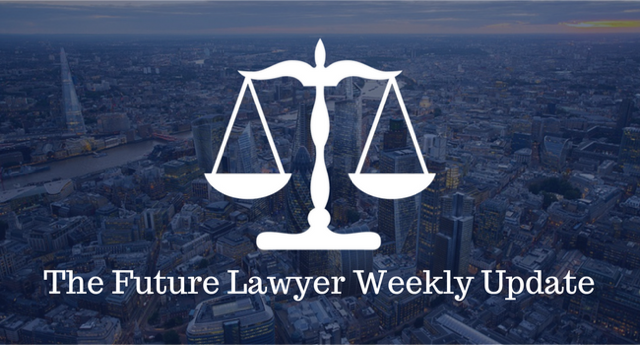
Top 5 books for Aspiring Lawyers
August 2, 2020
Hassan Tahir discusses how the recent amendments to the Parental Bereavement (Leave and Pay) Act 2018 have amended The Employment Rights Act of 1996
August 6, 2020The round-up of the stories that a budding Student Lawyer should be aware of this week. Sign up here to get these updates in your inbox every week.
Health and Covid-19
Update on ‘Care homes and COVID-19’
Reported by Katie Henderson
The House of Commons has labelled the policy, which allowed untested patients to be discharged into care homes, as ‘appalling’ and ‘reckless’. The cross-party public accounts committee (PAC) produced a report suggesting that the government’s policies on social care were ‘slow, inconsistent and at times negligent’. The Department of Health and Social Care has been criticised for continuing the policy despite it being ‘clear that there was an emerging problem’. When commenting on the report, the chair of the committee has said: ‘Our care homes were effectively thrown to the wolves, and the virus has ravaged some of them’. The report comes as a consequence of government backlash due to the handling of patients being transferred from hospitals into care homes. The committee has stated that approximately 25,000 hospital patients were discharged into care homes in order to free up beds. Public Health England was aware of asymptomatic transmission at the end of March, however discharged patients were not required to be tested for coronavirus until 15 th April. This may become a very vital point for the courts when considering claims against the government and the legality of their actions.
In regard to Cathy Gardner’s claim against the government, the full legal claim was filed on Friday 3 rd July and she has raised £86,760 (as of writing) to cover the legal costs. She condemns the Prime Ministers recent comments concerning the care home policies. In response to his statement that ‘nobody knew early on’ about asymptomatic transmission she says: ‘As my claim makes clear, the Government’s own advisory group warned as early as January 2020 that the virus could be transmitted by asymptomatic patients’. She also suggests that the government has attempted to shift the blame onto the care homes; quoting Boris Johnson as saying “We discovered too many care homes didn’t really follow the procedures in the way that they could have”. She argues the contrary and goes as far to say that the care homes were in fact forced to take in untested patients.
You can find more here or here.
Rights
Lockdown prison restrictions potentially breach children’s rights
Reported by Ellena Mottram
When the lockdown restrictions were introduced visits to prisons were halted. All prison visits were stopped on 24 March however some lawyers have claimed that the restrictions imposed on prisoners in England and Wales are breaching the human rights of their children.
The claim comes not only from the ban on visits to prisons but also the lack of video contact which has been offered during lockdown. This allegation comes as lawyers begin to take legal action against the Ministry of Justice. Lawyers are working with three families, two of prisoners in HMP Manchester and one in HMP Erlestoke have argued that the rules relating to prison visits breaches article 8 of the European Convention of human rights.
Article 8 provides the right to respect for your private and family life. This includes the right to enjoy family relationships without interference from the government. Where it is not possible to live with family members, this right includes the right to regular contact. Those acting for the families also allege the restrictions are a failure to properly safeguard the best interests of the children as required under the Children Act 2004. A government minister stated that measures were put in place to help maintain close bonds where possible. These measures included some prisons being issued with mobile phones and video links being set up. However, video links have not been made available in all prisons and therefore contact between family members have been limited with video calls only available in 56 prisons across the country.
On the 30 July letters the families sent letters before action to the Ministry of Justice relating to the treatment they have experienced. Highlighted in these letters was that the limit of phone contact did nothing for children who were too young to talk. The familiar are concerned that the lack of face-to-face contact will have a detrimental impact on their young children during their formative stages of development.
Additionally, families of children with disabilities have highlighted the limited phone contact has been distressing and has not provided their children with the contact they need. One lawyer acting on behalf of the families have stated that ‘The ongoing lack of action to protect these forgotten victims is not only a great legal concern, but also morally reprehensible in a society which so values human rights and promotes mental health’.
Individuals have called on MPs who were part of the joint committee on human rights to end the ban on children visiting their mothers in prison. This came as an estimated 17,000 youngsters may have gone without physical visits during the pandemic. A spokesperson for the Prison Service said that the decision to stop visits was not taken lightly and was based on public health advice.
The Ministry of Justice is yet to provide a response but have confirmed that they will respond to the letters in time.
Find out more here.
Trade
EU Trade Talks: Update
Reported by Jasmine Cracknell
The EU and the UK remain in talks over what their future trade relationship will look like, but after five formal rounds of negotiations, significant differences are proving difficult to overcome.
For the UK to leave with a deal at the end of the transition period on 31st December 2020, it is thought both sides will have to reach an agreement by mid-October in time for the EU summit. Both sides will also need time to ratify and sign off on the deal.
Whilst another formal round of trade talks is set to begin the week commencing 17th August, the Financial Times reports that Germany, the country currently holding the EU presidency, has said it will not give the trade talks its full attention until September. This could further hinder progress, making it even more likely a deal will not be reached until at least autumn.
Although many other important areas of the UK/EU trade relationship have been agreed upon, there are still several issues Michel Barnier, the EU’s chief negotiator, and David Frost, the Government’s chief negotiator are yet to reach a compromise on. These are the future role of the European Court of Justice (ECJ) in policing the deal, the EU’s ‘level playing field’ requirements, particularly on state aid; and fishing quotas.
- The Role of the ECJ
The EU wants the ECJ to be the avenue through which disputes under the deal are resolved, specifically where a question of interpretation of EU law arises. Should this happen, any decision of the ECJ would be binding on the UK. This is one of the UK’s red lines, especially as sovereignty and independence from the ECJ was one of the biggest arguments to leave the EU. According to the Financial Times, the EU may be willing to explore other dispute resolution options, but we do not yet know what these potential options are.
- Level Playing Field Principles
A further requirement of the EU is that the UK agree to its level playing field principles, particularly on environmental regulation, workers’ rights and state aid.
This is because the EU does not want the UK to begin a race to the bottom by lowering standards as this could give the UK a competitive advantage.
The regulation of state aid for businesses is the main sticking point. The UK plans to diverge from the EU’s current rules on state aid, not least because they do not want the ECJ to have authority in this area. According to the Financial Times, however, the EU may make a compromise in that they will not require the UK to accept state aid rules nor the oversight of the ECJ so long as the UK agree to a ‘shared philosophy’ regarding state aid. As part of this, the EU wants reassurances from the UK that a regulatory body would oversee state subsidies to businesses. Without this, the EU has made it clear there will be no “zero tariff, zero quota” access to the single market. The UK has provided no details to the EU on this as of yet, with David Frost stating ‘policy discussions’ are ongoing.
- Fishing Quotas
The final key issue yet to be agreed upon is EU fishing rights. The EU’s opening position was that it wanted the current rules to continue, such as full access to British waters, however it is likely the EU will have to compromise and accept fishing quotas. The details of this have yet to be agreed, but it is believed the UK is keeping this issue on the back burner to use as leverage when talks reach a vital stage in autumn.
You can find out more here and here.
Urban damage
Toppling Edward Colston
Reported by Oliver Murrell
Following an arrest and further police efforts to identify those involved in pulling down the infamous statue, I consider the laws they broke, and the hurdles prosecutors could face.
Whether you agree or disagree with the protestors who pulled down the statue of Edward Colston during a Black Lives Matter protest, what is unarguable is that they broke the law. Specifically, the Criminal Damage Act 1971. It is under this Act they would be prosecuted, but it is not the only factor that will come into play when the police look to prosecute those involved. The CPS Charging Test and jury sympathies will also be important in determining if the protestors will be convicted. But first, let’s consider the law.
It is under s.1(1) of the Criminal Damage Act 1971 the protestors likely committed the offence of criminal damage. Firstly, there is no lawful excuse the protestors could argue they had. Efforts to obtain lawful means of removing the statue proved ineffective, and certainly added fuel to an already raging fire, but widespread anger and approval does not constitute a lawful excuse. Next, the statue must be property belonging to another, and the statue was indeed the property of Bristol City Council. So, then the statue must have been “destroyed or damaged”. Whether the statue was “destroyed or damaged”, according to Roe v Kingerlee (1986), is to be determined through the common-sense of either the jury or magistrates. Applying common-sense, the toppling, graffitiing and throwing of the statue into a canal is clearly damage. All that is now left is the mens era. For anyone who has watched the video of the protestors pulling down the statue and throwing it into the canal, it is clear the protestors intended to damage the statue. Thus, there is a clear and obvious criminal damage offence.
However, there may be another offence. Contained within the same section of the same statute, aggravated criminal damage is set out in s.1(2) of the Criminal Damage Act 1971. The offence will be made out if the above criteria are established and that in damaging the property, there was endangerment to life.
It could be argued, quite persuasively, that pulling down a large bronze statue in the middle of a large crowd had the potential to injure someone quite seriously. Yet, while the protestors probably did not intend to endanger their fellow protestors lives, it is only necessary they were reckless as to the endangerment. To strengthen the case against the protestors, it is not even necessary that life was actually endangered. All that is required is the protestors were aware there was a risk that their pulling down of the statue could endanger life. There was certainly a serious risk that pulling down the large bronze statue would injure a fellow protestor.
Resultantly, the protestors appear to have committed an offence. Whether they are charged under s.1(1) or s.1(2), or leave both options to the jury, is up to the CPS. However, the CPS Charging Test must be passed. The first stage considers if there is enough evidence for there to be a realistic chance of conviction. That stage is almost certainly passed, but the second stage may not be. The CPS then consider if it is in the public interest to prosecute those involved, and this may cause an issue. The toppling of Edward Colston’s statue has been heralded by many as a heroic act that will stand as a defying moment in the Black Lives Matter movement, but it is also seen as a treasonous act by a great deal of others. There is certainly some public interest in prosecuting the protestors, and the CPS will be all too aware that whatever conclusion they reach, it will cause outrage amongst some.
It must also be considered how a jury will deal with the case against the protestors. A jury is a representation of the population, and the population is widely split on the toppling of the statue.
There are several cases of juries refusing to convict individuals in the face of overwhelming evidence, and the prosecution of the protestors could be one of those cases. It is likely that at least a few of the jurors will be of the opinion that pulling down the statue was a positive and justified act.
The protestors almost certainly committed a crime, but that certainly does not guarantee a guilty verdict or even that they will be charged.



